The back wall of the Hewitt Downstairs studio at the Montana Artists Refuge is about 15 feet by 20 feet. It was that wall that became the repository for a series of oil-painted panels called The Refuge. The Artists Refuge is in Basin, Montana; The Refuge is oil on canvas, a product of my two-month residency in Basin.
The Refuge is a visual rendition of a psychogeography of Basin, Montana — paintings that recall scenes and feelings arising from that particular place in that particular time and space of my life.
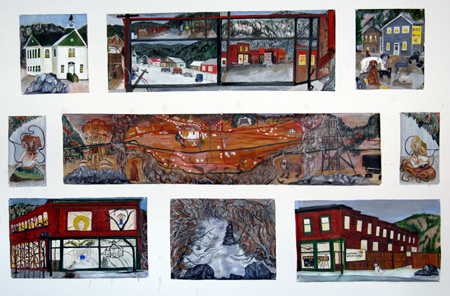
The Refuge, oil on canvas, Approximately 6′ x 10′.
I use the term “psychogeography” to speak of the process, but a better term to describe the artist/writer might be “flâneur.” Baudelaire speaks of the flâneur as a “botanist of the sidewalk.” (Another writer, Raymond Lucas quotes Walter Benjamin as an expositor of the form.) The flâneur is one who discovers meaning through actively engaging a place, generally a city, but here a village. The Refuge is not Basin, Montana, or even “Basin”, Montana. Rather it is a set of jeweled puzzles about a person, a time, a place; in short, an incomplete set of visual notions.
Early on in my Basin meanderings and with full knowledge that I was just one of many artists passing through the studio, I wanted to emboss my presence on the experience. So, I built obos. I painted obos. And then I put obos onto the Back Wall.
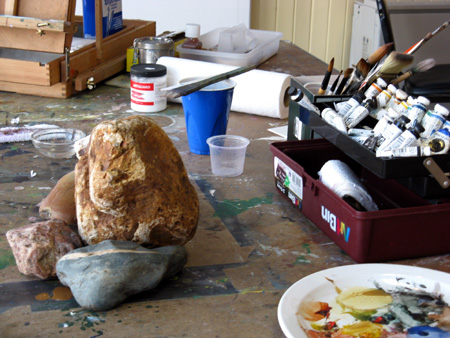
Rock pile on table, Studio
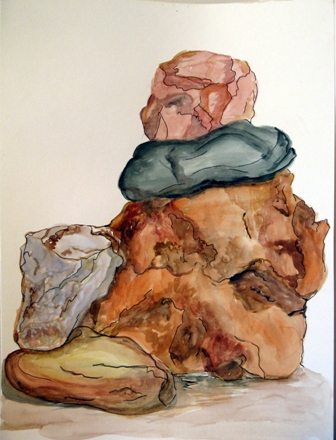
Obos, watercolor, 18″ x 24″
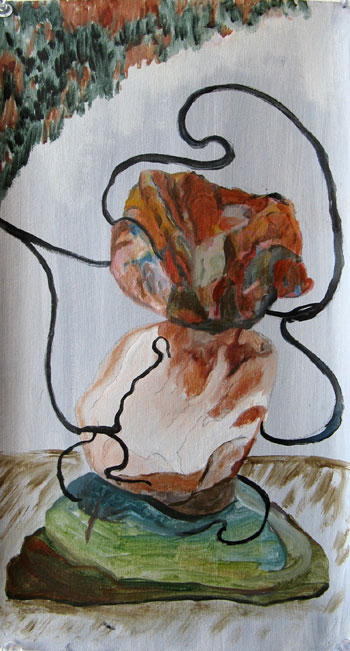 Obos with vines, middle right, The Refuge
Obos with vines, middle right, The Refuge
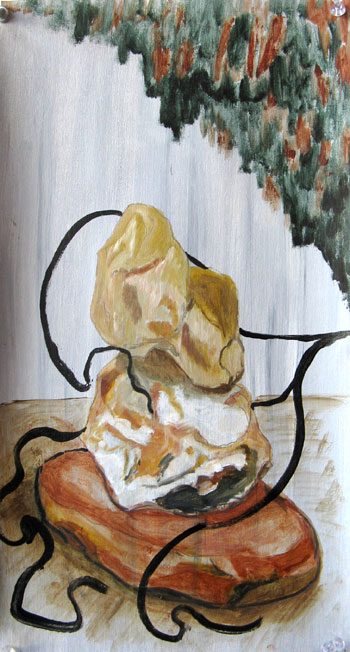 Obos with vine, middle left, The Refuge
Obos with vine, middle left, The Refuge
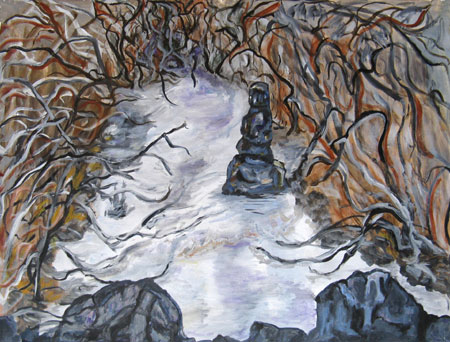
Cairns in Basin Creek, bottom middle, The Refuge
Obos — rock cairns — signify in multiple ways. One is the Japanese tradition of perching rocks one on another to say “I’ve Been Here”. Another is to identify the Boulder batholith, the humongous pile of upswollen granite and quartz that contains the metals that brought Basin into being. The other thing about rocks is that people in Basin collect them and place them, willy-nilly, everywhere. I simply continued the tradition, albeit in the back wall of the studio on the canvas that filled it.
Robert Genn, artist and blogger, says of obos: “Obos is a destination, a sanctuary, a shrine and a focal point that reminds us that we work with our hands…. Approach obos with a relaxed, curious mind. It can help with answers to questions not consciously asked. Obos gives pause, a contemplative thought or a new direction…. Obos is the carrier of a golden secret. Obos is like art itself. ”
The other element that had to be included in The Refuge is the studio. It was my living space for most of my working hours. It was spaciously empty when I started, filled while I was there, and empty again when I departed.
The bottom two panels of The Refuge show two versions of the building that houses the studio. The one on the right is relatively “straight,” the one on the left is filled with the eccentricities of my adventure. The studio is housed in what originated as the Hewitt Bank Building.
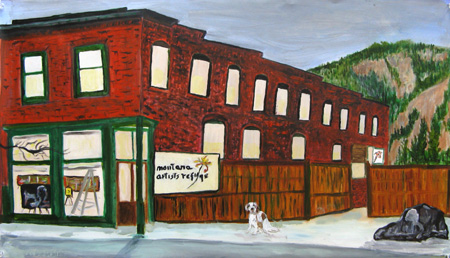
The Hewitt Bank Building, bottom right panel of The Refuge
The Hewitt Bank Building was built during the heyday of Basin, when there were 1,500 inhabitants, at least five whorehouses, one church, an elegant school, grocery and drygoods stores, and this bank. At least five buildings on Basin’s Main Street, including the Hewitt Bank Building, are constructed from brick. Another dominate feature of local scenery is the brick flume and stack, built by the Glass Brothers around 1900, that still dominate the entire village. I can attest to the stoutness and beauty of the brickwork in the flume and stack because one frigid day I scrambled up a snowy hillside to examine it. The flume is an extended arch of clean bricks, plummeting down hill through the woods toward the main street of Basin. The stack, also pristine, rises high into the sky at the top of the flume. Neither structure has ever been used. Bricklayers were undoubtedly much in demand during Basin’s boom times.
The bottom left panel makes more demands on the imagination.
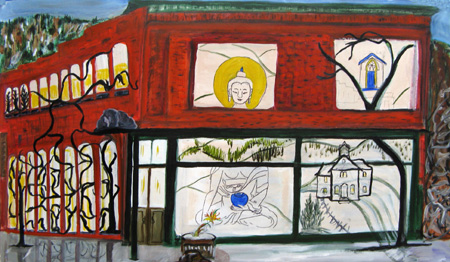
The tropical flower that is part of the Artists Refuge motto is blooming in a snow-covered barrel planter. A tree and a bunch of vines twine inside as well as outside the building. The batholith, threatening passers-by, perches above the front door, which is on the wrong side of the building, a side that in reality has no windows. A bit of the church, a cartoon of the school, some tree-covered hills, and a Buddha — all are depicted as inside the studio. The artist has taken her license and gone a bit wild. The Buddha actually did inhabit the studio (in the form of a 4 x 8 foot panel drawing) when I arrived but was banished to the back bathroom because An Artist was in residence. I wanted him to reappear so I decided he should join me in watching the town. Perhaps bless it, too.
The top panels tend to draw back a bit from the Refuge building, depicting again the eccentricities of the personal view. Rat Foot Lodge and a mine opening are on the far left of the left-hand panel. Basin Street (as it crosses Placer Avenue and goes by Basin Creek Pottery) and Quartz Avenue take up the larger central part of that panel.
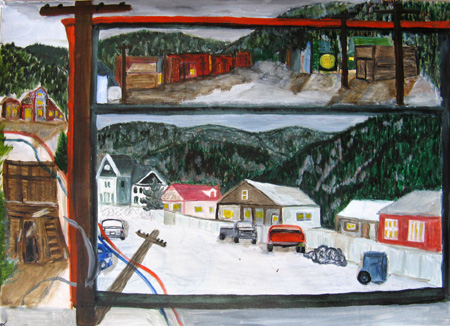
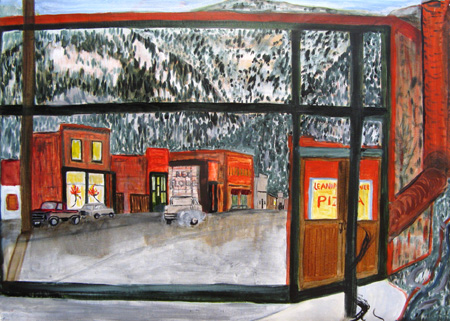
Beside that panel, on the top right-hand side, is a panel featuring the Basin Street “downtown” area, showing the Hewitt Building with its tropical flower, more wheeled vehicles, and the Leaning Tower of Pizza (the best pizza in town) overlooked by the Stack. The mountains rise above the street scenes.
The surround of both panels is the large north-facing studio window casings, the windows out of which I watched the townspeople go by, sometimes on foot, but more often in cars and trucks. They went by me to get pizza, to get a beer, to go home, to go to the Post Office. They often waved as they passed. And so those are the windows out of which I looked at the people of Basin looking into. Of such is the participatory nature of the roaming artist, both inside and out, looking in all directions. The flâneur , says Lucas, “walks to be observed as well as to observe others.”
The top far left and far right panels depict “important” buildings in Basin: in small towns, large and/or beautiful structures have a psychological importance disproportionate, perhaps, to what their impact would be in larger communities. On the left is Public School #5, the Basin Elementary School, built in 1895. The value of the school, with its 14 students, is captured by the beauty of the building, which stands out in a community in which cottages and trailer houses are the norms. I imagine a rather 19th century-ish conceit — that on the rock of the batholith was built the school; on the rock that is the school is built the community. It felt good to be both silly, and, I hope, somehow true.
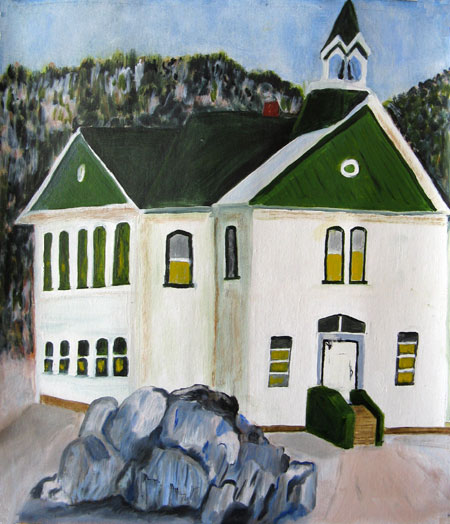
The other buildings that resonated with me were two older structures, now residential and commercial, but still rife with rumors of long-departed, shady pasts. The Stone House has been renovated and can be rented for the night or weekend, and the High Note, closed at the present, recently had been an espresso bar and “music hall.” The two buildings are a bit ungainly and not necessarily well proportioned, but they are prominent on Basin street and in the minds of the community. They seem to go together, to act in concert, if you will, joined at the hip.
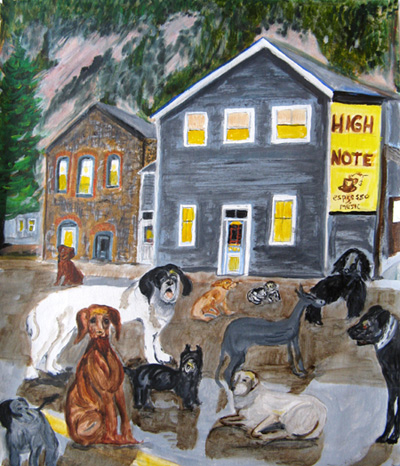
And the dogs? Well, Basin has many dogs. Many pampered dogs. I saw a truck owner who kept the window open on the dog’s side of the passenger seat so the dog could stick his head out and bark to his friends. In 10 degrees Fahrenheit weather. This is a Basin version of pampering a pet.
Painting the dogs became a kind of stand-in for portraying the Basin people. The dogs often gathered in the empty street outside the studio window and had their morning conclave and wrestling matches. The St. Bernard, Boozer, true politician as he is, in this panel joins and dominates the other Basin dogs outside the High Note. They are all waiting for the High Note to open up, so they can join the sing-along.
It’s Boozer who is the puppy in the bottom “straight” vision of the Artist’s Refuge — I think he’s been conning artists for some time and won’t stop when I leave.
Finally, the central large panel, the map of Basin (which because of its size, shows disproportionately small on the screen.)

Lucas speaks of the flâneur as “inscribing upon the city; writing rather than reading the city. This is an important distinction,” says Lucas, “as his (sic) spectatorship is an active one, which imposes his will upon the city streets, creating a narrative as he goes along.”
The map began with my hand-drawn copy of a Google street map. It quickly was personalized by my own vision and lack of cartographic experience. I needed to embed personal icons into the map. So I added the head frame and the mining cart on the right and the dogs and the Shiva on the left . The Shiva reflects some of the magic — destructive, instructive, generative — of the area. The head frame was a part of Basin until a few years ago, when it collapsed; the ruins are still extant. The mining cart now heads the Merry Widow (Radon) Health Mine just east of town. The streets and roads and streams run through the icons, and the whole is appropriately surrounded by natural features — hills, leafless shrubs, cloud-like connectors.
The map is both distorted and incomplete and that’s essential to what I wanted to express. It reflects what information I could garner by sliding around on the ice, counting houses and trying to remember the forms of buildings. What strikes me again is how complex this tiny place is and how little I could cover in the two frigid months I lived there. There are whole sections of housing that have been left out. I made one large error of street layout, siting some of the most imposing buildings on Basin street incorrectly. I left the error in place because it says something about the very narrow view, even of my most immediate surrounds, that I had of this place.
The map is central to The Refuge because while it began as a representational satellite image, it quickly became personal. The flaws come from my experience of the place, as do the icons, the color codings, the blank spaces, the sense of being held in the cupped hands of that basin in the mountains of Montana.

So I don’t believe I know Basin, Montana; I only know the narrative that I created. But it was full enough and complete enough that I could create The Refuge. For that, I shall always be grateful.
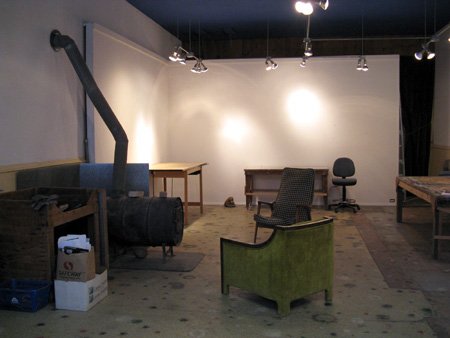
I apologize for the nature of this essay, for it is an essay and not a post. This “report” to Art and Perception is an attempt to say something of what Basin, Montana, meant to me and why the art called The Refuge is the encapsulation of that meaning. If it reminds you of art that you think somehow pulls together a moment of your existence, holding it visually, please tell us what and how and where…..

June lived in a fable.
A microcosm of an urban landscape inhabited by dogs.
June,
Last night, I watched Judy Foster’s movie about reinventing herself in NYC after the murder of her significant other – eye for eye, tooth for tooth. The movie was so convincing that I (not possessing a gun) felt like walking through streets in a slim black leather jacket with a glock in my pocket book, young, pervaded by a sense of loneliness. My friend Carolyn laughed at me, a mature, short person wrapped in a fire-engine-red down jacket.
Then, looking at your post, I was brought back to myself by your marvelous sense of humor. In depicting a Western outpost, instead of conveying an East Clintwood sense of fatality, you painted buildings that were childlike in their enthusiasm.
Doing my homework now I read about the concept of ‘flaneur’ as understanding, participating in and portraying a city, in the case of Baudelaire, as a cynical voyeur. That was not how you viewed your surroundings. You portrayed with joy de vivre.
I love your dog society.
The flow of your lines – curvatures in mountains, graceful bodies of dogs, vines that wrap – contrasting the straight lines and easily measured angles of the human habitats convey a sense of humor instead of surrealistic angst.
June,
You left a part of you in Basin, and you have taken a part of Basin away in you. Both you and Basin are blessed.
Barbara
Birgit and Barbara,
I think you’ve got me nailed.
The real difficulty is to fasten the naive enthusiasm with the (hopefully) intelligent educated brushstroke. It sometimes gets to be the bane of my personality — I want to be intellectual (and tall and elegant, too), but am generally perceived as enthusiastic. I guess that isn’t the worst one can be, though.
I did have frissons of fear in Basin, mostly related to dogs and drunken bullies from my youth. But I ignored the bully-fear (I didn’t actually find any bullies present in Basin) and I tamed the dogs, sort of, by painting them. But it was interesting to see that I knew a lot about tiny mountain hamlets that transferred, some 50–60 years later, to another time and place.
June, Your nine piece “The Refuge” is stark, eccentric, and very inviting. Whether you really know Basin is not the issue. You have clearly rendered those two months of your life with joy and affection. Magnificent! Congratulations!
PS, June,
Did I mention intriguing? thelma
Thanks, Thelma.
And now you know what obos is.
Re: the dratted nature of the singular sounding plural, and the origin in another language — Genn uses “obos” as a singular noun, and he seems to have more information than I do, so I follow him. But “obos is” does sound wrong to my native-speaker ears.
This is the very best visual and written representation of a solipsistic experience of place that I’ve come across – I mean this in the most positive sense. After all, our own personal reality is the one we know best and perhaps everyone else (and everywhere else) is simply a figment of our imagination, so what we see and experience and know is all there is.
Thanks, Jane,
You’ve caught it; “A visual and written representation of a solipsistic experience of place…”
It was surprisingly difficult to write about — and I’m finding it difficult to talk about when I show people the paintings.
Some art is more solipsistic than other — I think much of abstract painting is not about the paint, but about the personality putting the paint on canvas. And collage strikes me as terribly solipsistic, often in a less than positive sense. Photography, on the other hand, could be the least solipsistic art.
The Basin paintings appear to be more “real” more representational than the abstract work I also did. And certainly one of my aims was to be neither sentimental nor cynical about the place. But it’s only “real” in your sense — solipsistic, searching within oneself. The difficulty is finding the right words, neither sentimental nor cynical, to express what the paintings are supposed to do visually.
June,
Another tome, I’ll have to read most of it later, which I much look forward to. Got as far as your obos. I love your watercolor and the obos concept, but I’ve always thought Genn or somebody made this up. Of course there have been cairns to aid travelers forever, and they’ve often been of great value to me, especially in the rocky west (paths don’t show wear) and in Japan, where I’m only aware of the name ishidzuka for them. It is fairly common to carry a pebble to place at a shrine or similar location, but in three years of hiking around I don’t recall seeing stone piles in other than sacred or navigational locations. Also, obos doesn’t sound like a Japanese word and it is not in any of my dictionaries. But I certainly could be wrong in this and I would really like to know if anyone has authoritative information on it.
Addendum: just checked for obos on any Japanese web sites via Google, and within a few pages found only this reference to an account from a European expedition in China. June will be glad to know that obo is used in the singular.
“And collage strikes me as terribly solipsistic, often in a less than positive sense.”
Well, I’m starting to view myself as much more of a collage artist who happens to work in fiber than a fiber artist so I’d have to say that while I can agree with your statement for some (okay, a lot of) collage artists, I see mine as giving voice to my subconscious. I guess that’s the same thing, but it doesn’t sound as narcissistic or self-involved. And it sounds “deep” enough to go in one of those dreaded artist statements.
Steve,
Maybe it’s Chinese, not Japanese. I too have googled around about obos and never saw it anywhere but Genn. I’m sure I heard it elsewhere, but I could just be making that up. You are one up on me for finding a different reference.
Sorry about the tome. Perhaps I should find post on a day of the week, and a week of the month and a month of the year when no one else is posting at all. Then you could feel grateful instead of burdened (you’ll have to add your own snort).
Jane, you can do fiber and have it project your subconscious all you want and even be seriously solipsistic and I know I’ll enjoy it. But I do sigh a lot over our fellows in the fiber arts. I’m thinking of things like composition and finding ways into and through the surface and not having quite so many photos of quaint old timey things.
June,
I’ve seen obos elsewhere, but always referenced to Genn or clearly derived therefrom. And don’t apologize about the tome, I don’t mind taking time over it, and will when I can tomorrow. Some may skim, that’s fine too. It does seem to have gotten busy in my brief absence.
June:
There are web-based companies that allow one to economically self publish. The one I have in mind creates a nice product with glossy stock, good color renditions and bindings. If you would care to create a report of your time of Refuge in such a medium, then I would buy one pronto.
I have to agree with others here that, among your virtues – and they are many – an enthusiastic embrace of life stands out. Keep it up.
June,
I have to agree with Jay that your “enthusiastic embrace of life stands out” in The Refuge as well as in your writing.
Trying to come to grips with your masterpiece, I felt like I was vicariously re-living your time at the Refuge. In the end I came to the following conclusion, which I hope you will critique.
Because of the length of time you spent in Basin, your pictorial statement comes out quite different from the sequential narrative of the flâneur. In your back and forth over two months, you passed many times the places that structure the village and form the landmarks of your mental geography. You were able to organize your visual representation of it all according to a rather strong symmetry, which seems to say that you have established at least a provisionally settled and comfortable understanding of your Basin. The work is literally an “encapsulation,” surrounding the distorted map with an orderly frame of personal meanings.
You might say this painting is your obos, showing that someone has, in the fullest way, been here before.
June,
I am reminded, looking at an artistic expression, that there is always something deeper
…and I tamed the dogs, sort of, by painting them. But it was interesting to see that I knew a lot about tiny mountain hamlets that transferred, some 50–60 years later, to another time and place.
Steve,
Thanks for the insight. I think you are quite right and it isn’t something I had consciously noticed.
The “encapsulation” works in exactly that way for my internalization of the Basin experience. I have a sense that I have finished with it — at least with that particular sense of it — staying another month would not have produced anything of much more use. Staying another 20 years would certainly have produced a very different version, but for a short termer in the winter, I had done all I could do. The essay was an attempt to wrap in words what the visuals wrapped around the distorted map.
Thank you.
June,
i have a feeling you have just scratched the surface, psychologically and geologically, regarding your time in Basin and more insights will surface later, as the surface gets weathered by the elements (to stretch the metaphor a bit thin).
i have seen obos on the slopes of Kilauea volcano, holy places left by Hawaiians (probably quite modern, not ancient) to show respect for Pele. I think I’ve seen references to such rock piles made by Inuit people also. Material is ready to hand.
As a cartographer in my previous life, I appreciate your mental map of Basin very much. “Mental maps” were actually a part of my academic schooling and are quite respectable. Could be a whole ‘nother series for you – mental maps of your special places?
Jay,
What to do with the detritus of the adventure is a whole ‘nother question, one that wearies me. We had a prolonged discussion with friends yesterday about how to mount and then display the whole of The Refuge and I came away in a peculiar despair.
The self-publishing is an interesting thought. It appeals to me on a number of levels, while at the same time it all sounds, as my daughter was wont to say about chemistry, “toooooo haaaaard.”
I suspect I may need some kind of vacation.
June:
Toooo Eeaassyy actually. My wife created a story book about an adventure she had had with Wolfgang, and did so using something called Picaboo. She informs me that there are a “ton” of such sites. Essentially, Picaboo, as an example, operates similarly to A&P in that one creates copy and pictures to a web site. Unlike A&P,one can then custom order a completed and bound publication. The 8″ x 11″ publication, bound in cloth and with a window in the cover, was $30. Don’t know if that is a lot of money or little for the product at hand.
June:
And if that does seem to be a lot, do remember that every form of Refuge has its price.
Eileen,
Our comments crossed in the ether.
I’m not sure if your first idea (“more insights will surface”) referred to the specific location or to insights about the nature of place in general. I am finished with Basin, I think. I can only imagine doing a few painterly tweaks to The Refuge and one or two to the earlier 12 x 16″ images; I won’t be adding anything to them, so far as I know. So any insights for that specific place will be incidental and probably 3 AM sleep notions.
I have seen mental maps, or visual/ journal like maps, but I find them a bit twiddly, hodge-podgy (I suspect that’s my same problem with much collage.) But as a central image with the simpler surrounding images, they worked here. We’ll see what happens next. I do love looking at and trying to suss out maps in accordance with visual perceptions.
Jay,
$30 sounds about right. One of my problems is that I live with a writer and gave birth to another, so the thought of committing my words to “publication” makes me quiver with fear. But I like the idea of binding the narrative and concepts to the visuals, so I may have to overcome my knocking knees. We’ll see. I am considering it seriously. Thanks for the suggestion.
June:
Forsooth? You know you’d do a great job. And I await the chance to fork it over for my very own copy.
Jay and June,
I’m hoping to try my hand at some print-on-demand publishing soon, so maybe I’ll have some experience to share with you later.